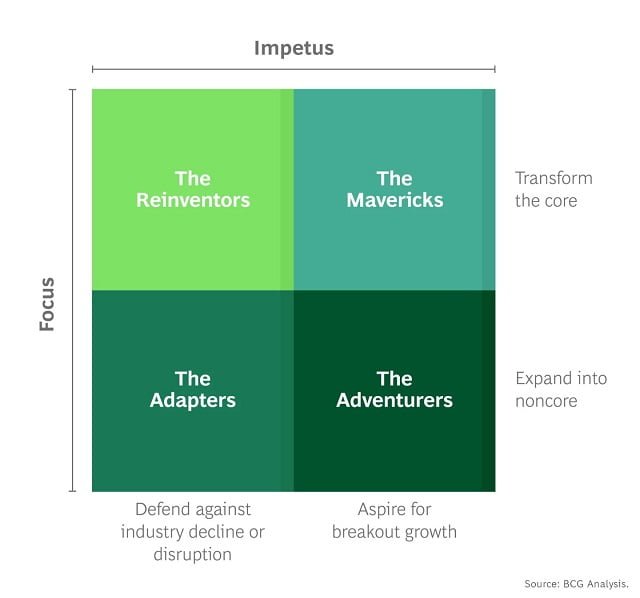
In today’s rapidly evolving business landscape, characterized by technological advancements, shifting consumer preferences, and increasingly intense competition, innovation in the business model has become a critical imperative for organizations seeking not only to survive but also to thrive. This transformative approach involves reimagining a company’s fundamental structure, encompassing its value proposition, customer relationships, operational processes, and financial mechanisms, to create a competitive advantage and drive sustainable growth.
In a competitive environment, companies must review and transform their business models, as they need to be adapted and strengthened to create or maintain competitive advantages. Scientific studies have shown the importance of innovation in business models, and top executives of global corporations predict that its necessity will surpass even the importance of innovation in products and services (Moradi et al., 2021).
In this regard, large multinational corporations perceive business model innovation as a key activity to remain competitive, thereby generating new products or services for customers, and hence, new revenue streams. In this article, we present a theoretical approach to business model innovation, describing the types and the process you should follow.
What is Business Model Innovation (BMI)?
One of the challenges we face as entrepreneurs is defining what business model innovation really entails.
In this regard, Girotra and Netessine (2014) highlight that without a framework for identifying opportunities, it is difficult to be systematic about the process. In this sense, Business Model Innovation, according to Vils et al. (2017), “refers to the creation and acquisition of value by companies, based on the organization of their internal processes and external relationships with their customers and suppliers.”
On the other hand, Euchner and Ganguly (2014) emphasize that business model innovation is “any innovation that creates a new market or disrupts the competitive advantage of major competitors”; while the Boston Consulting Group defines business model innovation as: “the art of improving advantages and value creation through simultaneous (and mutually supportive) changes both in an organization’s value proposition to customers and in its underlying operational model.”
Essentially, business model innovation represents the process of fundamentally altering how a company creates, delivers, and captures value for its customers and stakeholders. It challenges the status quo, disrupting traditional norms, and redefining the rules of engagement within an industry. This dynamic approach allows organizations to unlock new revenue sources, expand market reach, and establish a differentiated position in the market.
Value Generation
Your company delivers value by creating solutions (products or services) that the market (customers) needs. As Baiya (2021) explains, when you deliver significant value, the market rewards you with increased customer loyalty, profits, and a future. Thus, the ongoing updating of your business model must prioritize value generation for your customers.
On the other hand, technological advancements (e.g., artificial intelligence, the Internet of Things, 3D printing, etc.) are changing the competitive landscape; thus, digital transformation has impacted value creation, delivery, and capture in almost every industry (Vasta et al., 2021).
Pillars of Business Model Innovation
Sjödin et al. (2020) highlight that the effectiveness of business model innovation depends on the three phases of the process that are developed in collaboration with customers: defining the value proposition, designing value provision, and delivering value in use. These phases can be defined as:
- Value Creation: At the heart of any successful business model lies the ability to create value. This dimension explores how companies generate and enhance value through their products, services, or processes.
- Value Proposition: The way a company presents its value to customers is crucial. This dimension examines the uniqueness and attractiveness of a company’s offerings and how well they align with customer needs.
- Value Capture: Beyond creating and proposing value, capturing it is equally essential. This dimension investigates the strategies companies employ to monetize their offerings and maintain profitability.
Types of Business Model Innovation
The world of business model innovation encompasses a wide range of approaches, each designed to address specific business challenges and opportunities. Some of the most common types of business model innovation include:
Value Proposition – Differentiation
We must start by ensuring that we have a clear idea of the value that innovation will create for customers. In other words, why do customers prefer our products or services?
Also, you should not assume that your customers understand the value you provide them. You must remind them of your value proposition continuously to differentiate yourself from your competitors. This approach emphasizes the creation of unique value propositions that distinguish the business from the competition.
Cost Leadership
This strategy focuses on minimizing operating costs to offer products or services at the lowest possible price. In this sense, you should evaluate whether your pricing strategy allows you to generate sufficient profits and if it is sustainable to help you grow.
Customer Acquisition
Review how you engage and develop relationships with your customers. You need to have different levels of relationships and approaches. Girota & Netessine (2014) recommend that companies can select a variety of products or markets to reduce overall risk.
Where can you find and communicate with your customers? Who influences your customers? The answers to these and other questions will help you understand your customers’ behavior and needs.
User Experience
Ensure that it is easy for your customers to access your products or services. Also, it is essential to make changes to your company’s product or service mix.
Are your customers appreciating the value of your solution? Do you have the opportunity to provide more value with the current user experience?
Niche Market Focus
This strategy involves targeting a specific market segment with customized products or services.
Multilateral Business Model
This model involves creating value for multiple stakeholder groups, such as customers, suppliers, and partners.
Innovation Approaches in Business Models
Executives of companies aiming to drive their growth through business model innovation must confront a series of doubts and risks. However, to help them mitigate the risk of their innovations, the consulting firm Boston Consulting Group (BCG) proposes 04 approaches:

Here’s a description of each approach outlined by BCG.
Reinventor
Implemented in light of a fundamental industry challenge, such as commoditization or new regulation, where the business model is slowly deteriorating and growth prospects are uncertain.
In this situation, the company must reinvent its value proposition and realign its operations to deliver a superior product or service that enables maintaining or increasing profits.
Adapter
Used when the core business, even if reinvented, is unlikely to face disruption.
Adapters explore adjacent businesses or markets, sometimes abandoning their core business altogether.
Adaptation should build an innovation engine to persistently drive experimentation to find a successful “new center” with the right business model.
Maverick
Implements business model innovation to scale a potentially more successful core business.
Mavericks, who can be startups or established insurgent companies, leverage their primary advantage to revolutionize their industry and set new standards.
The maverick approach requires the ability to continuously develop competitive advantage or business advantage to drive growth.
Adventurer
This approach aggressively expands a company’s footprint by exploring or venturing into new or adjacent territories.
Companies must have an understanding of their competitive advantages and make careful bets on novel applications of those advantages to succeed in new markets.
Benefits of Business Model Innovation
The benefits of adopting innovation in business models are manifold and go far beyond mere financial gains. By embracing this transformative approach, organizations can:
- Enhance customer satisfaction: By aligning value propositions with changing customer needs and preferences, companies can foster deeper customer engagement and loyalty.
- Create a competitive advantage: By differentiating their offerings and establishing a unique value proposition, companies can gain a decisive edge over rivals. Increased value creation will lead to greater growth.
- Accelerate growth: By unlocking new market opportunities and expanding revenue streams, companies can achieve exponential growth and scale. Business model innovation significantly contributed to productivity growth in UK companies between 2003 and 2017.
- Improve agility and adaptability: By fostering a culture of innovation and embracing change, companies can respond quickly to market changes and emerging trends.
- Ensure long-term sustainability: By building a resilient and adaptable business model, organizations can ensure their continued success in the face of changing market dynamics. There is a significant positive impact of business model innovation on corporate sustainability.
Results of Business Model Innovation
Andreini and Bettinelli (2017) developed a thematic map of the main outcomes of business model innovation.
Table 01. Results of Business Model Innovation.
Aquí tienes la tabla:
| Area of Results | Characteristics |
|---|---|
| Economic Performance | – Actual economic performance: profits, company’s market value, market share growth. – Perceived economic performance: market performance and profitability growth. – Corporate survival. |
| Value | – Value creation: economic value of the customer, efficiency, effectiveness, and customer engagement, value creation process. – Competitiveness. – Value appropriation: operational efficiency, value capture. |
| Industry Level | – Industry structure – Disruptive innovations |
| Strategy | – Organizational boundaries – Internationalization – Others: cost reduction and strategy flexibility. |
Examples of Business Model Innovation
History abounds with notable examples of companies that have revolutionized their industries through innovation in business models. These pioneering organizations serve as inspiration, demonstrating the transformative power of reinventing the business landscape.
- Airbnb: This hospitality giant transformed the travel industry by leveraging a peer-to-peer platform to connect homeowners with travelers seeking unique lodging experiences.
- Uber: This transportation disruptor redefined the taxi industry by introducing a mobile app-based platform that streamlined the booking and payment process.
- Netflix: This entertainment pioneer revolutionized the home entertainment industry by transitioning from traditional DVD rental to a subscription-based streaming service.
- Amazon: This e-commerce giant revolutionized the retail landscape by introducing an online marketplace offering a wide selection of products at competitive prices.
- Apple: This tech innovator constantly redefines the consumer electronics industry with innovative products and services, such as the iPhone, iPad, and App Store.
Business Model Innovation Process
To effectively navigate the complexities of business model innovation, organizations can leverage a structured framework to guide the process from ideation to implementation. A comprehensive framework typically encompasses the following phases:
- Understanding the current business model: This initial step involves thoroughly analyzing the existing business model, and identifying its strengths, weaknesses, opportunities, and threats.
- Identification of innovation opportunities: Through market research, customer insights, and competitive analysis, organizations can identify areas ripe for innovation. For example, the impacts of disruptive technologies have led to the adoption of a variety of new business models, such as frugal innovation and the circular economy.
- Generation of business model concepts: This phase involves brainstorming and evaluating a wide range of novel business model ideas. Haftor and Costa (2023) identified five dimensions of a business model that, when modified, can result in business model innovation by established firms: interchangeable, activity, actor, transaction mechanism, and governance configuration.
- Evaluation and selection of concepts: Each business model concept is rigorously evaluated based on its feasibility, potential impact, and alignment with the organization’s strategic objectives.
- Prototyping and testing: Selected concepts are transformed into tangible prototypes for testing and refinement through customer feedback and market validation.
- Implementation and scaling: Once validated, the chosen business model is implemented organization-wide, ensuring alignment with internal processes and systems.
- Monitoring and Adaptation: Continuously monitor the performance of the new business model, making necessary adjustments to optimize its effectiveness.
However, without serious commitment from top management to innovation, any effort will not have the desired impact. Dinibutun’s research (2024) highlights the significant impact of entrepreneurial passion on business model innovation.
On the other hand, Sjödin et al., (2020) propose a process model for business model innovation by providing a deep understanding of how alignment of value creation and capture processes is ensured, paying special attention to their interdependence and the interactions between provider and customer; while Korsgaard et al., (2022) identify four critical activities of the business model innovation process: (1) assessing the environment for new opportunities, (2) conveying a sense of urgency, (3) exploring and testing new opportunities through experimentation, and (4) managing decision-making with a combination of intuition and data.
360-Degree Business Innovation Model
Rayna and Striukova (2016) proposed a comprehensive framework called the “360-Degree Business Innovation Model” that addresses the lack of tools to examine business models in their entirety, combined with the complex relationship between changes in business models and market outcomes, providing an integrated, value-based view of all critical components of the business model.
The various elements that constitute a business model, some key components are mentioned more frequently:
- Value creation,
- Value proposition,
- Value capture,
- Value delivery, and
- Value communication.
Conclusion
Business model innovation is an approach that business managers must master so that the organization can maintain its competitiveness, but above all, to adapt to the new business environment. In this sense, fostering a culture of innovation and making use of a series of tools will allow us to capture customer needs and create value propositions that meet those needs.
Likewise, new technologies are changing the business environment, so business model innovations will become a constant, as companies need to adopt these new digital technologies.
References
Andreini D. & C. Bettinelli. 2017. Business Model Innovation.
Boston Consulting Group. Business Model Innovation.
Baiya E. 2021. 6 Ways to Innovate your Business Model. Innovation Management.
Dinibutun, S. R. (2024). The impact of entrepreneurial passion on business model innovation on Turkish SMEs. Cogent Business & Management, 11(1), 2291864.
Euchner J. & A. Ganguly. 2014. Business Model innovation in Practice. Research-Technology Management.
Girota K. & S. Netessine. 2014. Four Paths to Business Model Innovation. Harvard Business Review.
Haftor, D. M., & Climent Costa, R. (2023). Five dimensions of business model innovation: A multi-case exploration of industrial incumbent firm’s business model transformations. Journal of Business Research, 154, 113352. https://doi.org/10.1016/j.jbusres.2022.113352
Kajtazi, K., Rexhepi, G., Sharif, A., & Ozturk, I. (2023). Business model innovation and its impact on corporate sustainability. Journal of Business Research, 166, 114082. https://doi.org/10.1016/j.jbusres.2023.114082
Korsgaard Andersen, T. C., Aagaard, A., & Magnusson, M. (2022). Exploring business model innovation in SMEs in a digital context: Organizing search behaviours, experimentation and decision-making. Creativity and Innovation Management, 31(1), 19-34. https://doi.org/10.1111/caim.12474
Menter Matthias, Lutz Göcke, Christopher Zeeb, Thomas Clauss. 2023. Disentangling the complex longitudinal relationships between business model innovation and firm performance, Journal of Business Research, Volume 168, 2023, 114229, ISSN 0148-2963, https://doi.org/10.1016/j.jbusres.2023.114229.
Moradi, E., Jafari, S. M., Doorbash, Z. M., & Mirzaei, A. (2021). Impact of organizational inertia on business model innovation, open innovation and corporate performance. Asia Pacific Management Review, 26(4), 171-179. https://doi.org/10.1016/j.apmrv.2021.01.003
Rayna, T., & Striukova, L. (2016). 360° Business Model Innovation: Toward an Integrated View of Business Model Innovation: An integrated, value-based view of a business model can provide insight into potential areas for business model innovation. Research-Technology Management, 59(3), 21–28. https://doi.org/10.1080/08956308.2016.1161401
Sjödin, D., Parida, V., Jovanovic, M., & Visnjic, I. (2020). Value Creation and Value Capture Alignment in Business Model Innovation: A Process View on Outcome-Based Business Models. Journal of Product Innovation Management, 37(2), 158-183. https://doi.org/10.1111/jpim.12516
Vaska, S., Massaro, M., Bagarotto, E. M., & Dal Mas, F. (2021). The digital transformation of business model innovation: A structured literature review. Frontiers in Psychology, 11, 539363.
Vils, Leonardo; Mazzieri, Marcos Rogério; Rodrigues, Gustavo Viegas; Silva, Alexandre Rodrigues Da. BUSINESS MODEL INNOVATION: A BIBLIOMETRIC REVIEW. International Journal of Innovation, vol. 5, no. 3, 2017
Wannakrairoj, W., & Velu, C. (2021). Productivity growth and business model innovation. Economics Letters, 199, 109679. https://doi.org/10.1016/j.econlet.2020.109679
Editor and founder of “Innovar o Morir” (‘Innovate or Die’). Milthon holds a Master’s degree in Science and Innovation Management from the Polytechnic University of Valencia, with postgraduate diplomas in Business Innovation (UPV) and Market-Oriented Innovation Management (UPCH-Universitat Leipzig). He has practical experience in innovation management, having led the Fisheries Innovation Unit of the National Program for Innovation in Fisheries and Aquaculture (PNIPA) and worked as a consultant on open innovation diagnostics and technology watch. He firmly believes in the power of innovation and creativity as drivers of change and development.





